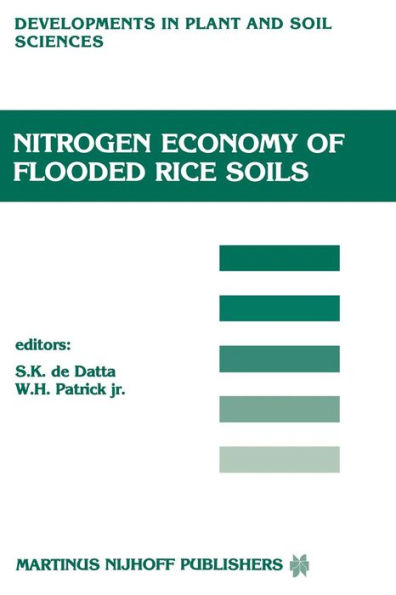Nitrogen Economy of Flooded Rice Soils: Proceedings of a symposium on the Nitrogen Economy of Flooded Rice Soils, Washington DC, 1983
The steadily increasing cost of nitrogen fertilizer has resulted in more emphasis on basic and applied studies to improve nitrogen use efficiency in lowland rice. The efficiency of fertilizer nitrogen in farmers' fields is shockingly low ~ a luxury resource-scarce farmers in tropical Asia can ill afford. We believe it is critical to quantify the basic transformation processes and develop management practices for higher N use efficiency for two reasons. They are: 1. Nitrogen fertilizer together with water management is a key factor for achieving the yield potentials of modern rices. 2. Fertilizer nitrogen prices are high and most Asian rice farmers are poor. The International Rice Research Institute (IRRI), Philippines; Internation al Fertilizer Development Center (IFDC), USA; Commonwealth Scientific and Industrial Research Organization (CSIRO), Australia; U.S. Universities (Louisiana, Cornell, California, Arkansas and others); and Dr Justus Leibig University in West Germany are actively engaged in individual or collaborative research that addresses basic transformation processes on N gains and losses and management practices to maximize N use efficiency in rice. It is appropriate to update and summarize, in a double issue of Fertilizer Research, the 10 papers presented at the special symposium organized by the American Society of Agronomy (ASA) at the 75th Annual Meeting in Washington, D.C. in 1983. S.K. De Datta, Head of Agronomy Department, IRRI, was chairman of the International Agronomy Division of ASA (A-6) in 1982 and 1983.
"1117013136"
Nitrogen Economy of Flooded Rice Soils: Proceedings of a symposium on the Nitrogen Economy of Flooded Rice Soils, Washington DC, 1983
The steadily increasing cost of nitrogen fertilizer has resulted in more emphasis on basic and applied studies to improve nitrogen use efficiency in lowland rice. The efficiency of fertilizer nitrogen in farmers' fields is shockingly low ~ a luxury resource-scarce farmers in tropical Asia can ill afford. We believe it is critical to quantify the basic transformation processes and develop management practices for higher N use efficiency for two reasons. They are: 1. Nitrogen fertilizer together with water management is a key factor for achieving the yield potentials of modern rices. 2. Fertilizer nitrogen prices are high and most Asian rice farmers are poor. The International Rice Research Institute (IRRI), Philippines; Internation al Fertilizer Development Center (IFDC), USA; Commonwealth Scientific and Industrial Research Organization (CSIRO), Australia; U.S. Universities (Louisiana, Cornell, California, Arkansas and others); and Dr Justus Leibig University in West Germany are actively engaged in individual or collaborative research that addresses basic transformation processes on N gains and losses and management practices to maximize N use efficiency in rice. It is appropriate to update and summarize, in a double issue of Fertilizer Research, the 10 papers presented at the special symposium organized by the American Society of Agronomy (ASA) at the 75th Annual Meeting in Washington, D.C. in 1983. S.K. De Datta, Head of Agronomy Department, IRRI, was chairman of the International Agronomy Division of ASA (A-6) in 1982 and 1983.
54.99
In Stock
5
1

Nitrogen Economy of Flooded Rice Soils: Proceedings of a symposium on the Nitrogen Economy of Flooded Rice Soils, Washington DC, 1983
194
Nitrogen Economy of Flooded Rice Soils: Proceedings of a symposium on the Nitrogen Economy of Flooded Rice Soils, Washington DC, 1983
194Paperback(Softcover reprint of the original 1st ed. 1986)
$54.99
54.99
In Stock

Product Details
| ISBN-13: | 9789401084710 |
|---|---|
| Publisher: | Springer Netherlands |
| Publication date: | 10/02/2011 |
| Series: | Developments in Plant and Soil Sciences , #26 |
| Edition description: | Softcover reprint of the original 1st ed. 1986 |
| Pages: | 194 |
| Product dimensions: | 6.10(w) x 9.25(h) x 0.02(d) |
From the B&N Reads Blog
